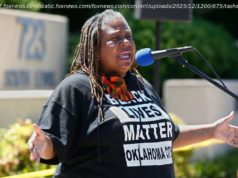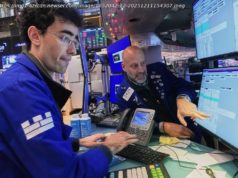Huge arms deal with Saudi Arabia, NATO-like alliance and tough talk are all aimed at Iran.
President Trump used his first foreign trip to repeatedly blast Iran for its aggressive behavior, a topic that unifies U. S. allies in the region, especially Saudi Arabia and Israel.
Trump has been a staunch critic of the Iran nuclear deal brokered by the U. S. and other world powers that was implemented in January 2016. The president has allowed the deal to remain in place but has focused on Iran’s missile development and support for terrorism in Iraq, Syria and Yemen.
“Iran should be very grateful to the United States. Iran negotiated a fantastic deal with the previous administration, ” Trump said Monday in a joint appearance with Israeli Prime Minister Benjamin Netanyahu in Jerusalem. “No matter where we go we see the signs of Iran in the Middle East.… Yemen, Iraq, no matter where we are we see the signs, whether it’s soldiers, whether it’s money and guns. Instead of saying thank you to the United States, they now feel emboldened.”
Trump’s Iran-bashing comes as the country re-elected Friday a relatively moderate President Hasan Rouhani, who wants to engage more with the West. Rouhani’s victory against hard-liners took place in a system where candidates are pre-approved by Iran’s religious supreme leader, yet the 70% turnout was high by any democratic standard.
Here’s a breakdown of why the U. S., Arab nations and Israel are worried about Iran:
Syria — Iran has sent thousands of troops to fight alongside forces loyal to Syrian President Bashar Assad against rebels trying to oust him. Iran’s Islamic Revolutionary Guard Corps also has recruited and paid thousands of militia members from Hezbollah in neighboring Lebanon, from Iraq and as far away as Afghanistan and Pakistan to join the fight.
Together with a Russian air campaign, these mostly Shiite ground forces have kept Assad in power, against a mostly Sunni opposition, in a war that has left more than 400,000 deaths and displaced millions, according to the State Department.
The Iran-backed forces number in the tens of thousands and constitute a ground presence that gives Iran a say at the negotiating table where the eventual outcome in Syria is being discussed, said Suzanne DiMaggio, a senior fellow at the New America Foundation, a Washington think tank.
The Syrian political opposition, supported by Washington and Sunni Arabs led by Saudi Arabia, want Assad to step down as part of any political solution. But the Iranians have other ideas.
“The Iranians have put forward a proposal for dealing with the Assad issue down the line, a transfer of power after elections, ” DiMaggio said.
Trump has not drafted a clear policy for resolving the conflict. As a candidate, Trump said he would prioritize defeating the Islamic State in Syria and Iraq. On April 7, Trump ordered 59 missiles to be fired at a Syrian air base in retaliation for Assad’s use of chemical weapons on his people. And on Thursday the U. S. struck an Assad military convoy, which it said came too close to American forces.
“It’s up in the air what the U. S. policy in Syria is now, ” DiMaggio said.
Yemen — Iran supports Houthi rebels fighting a civil war against the internationally recognized government in Yemen, which is supported by a Saudi-led coalition. The Iranian support includes training and weapons that have been used in increasingly deadly attacks, such as one in January that crippled a Saudi patrol ship.
The Houthis are a Shiite minority that is fiercely independent and not entirely under Iranian control, and they are modifying Iranian-supplied weapons to make them more deadly. That raises the risk that U. S. troops or ships could be attacked — an escalation that could trigger a direct conflict between the U. S. and Iran, DiMaggio said.
And the multibillion-dollar weapons deal announced by Trump in Saudi Arabia over the weekend means more Saudi weapons will enter the Yemen conflict, she said.
“That’s one of the biggest concerns, ” she said. Trump’s „one-sided support for Sunni Arabs against the Shia unnecessarily stokes tensions in an already volatile area.”
Support for terrorism — While the State Department lists Iran as the world’s top state-sponsor of terrorism, the weapons deals and a NATO-like alliance announced in Saudi Arabia on Saturday are meant to deter Iran’s conventional military threat.
The agreements include Theater High Altitude Area Defense (THAAD) system against Iranian missiles, patrol boats and stronger coordination between U. S. and Arab states in the Persian Gulf, according to media reports.
“What it doesn’ t contain is any clear approach … to counter Iran’s asymmetric threat, ” said Paul Salem, an analyst at the Middle East Institute in Washington. He said Iran has advanced weapons but uses them mostly as deterrent while attacking countries in the region with terrorist groups. These include Shiite militias in Iraq who killed many U. S. troops during the Iraq war, Hamas and the Islamic Jihad in the Gaza Strip who have launched attacks on Israel.
Nuclear and missile programs — Iran’s nuclear and missile programs did not end under the nuclear deal negotiated by the Obama administration. The landmark agreement did not address Iran’s missile program and allows for a nearly unlimited expansion of Iran’s nuclear infrastructure after a decade.
While U. S. Arab allies in the Persian Gulf and Israel want to preserve the deal for now, this “sunset provision” worries them because they believe it will give Iran the capability to secretly produce weapons-grade fuel for a bomb in the future, DiMaggio said.
Iran’s Rouhani, during his campaign, pledged to work toward lifting remaining non-nuclear sanctions against Iran, which target the country’s missile program, support for terrorism and human rights abuses.
Rouhani’s vow is “an opening to re-open negotiations that address many of the outstanding issues that remain with Iran, ” DiMaggio said. „This is the platform that Rouhani ran on and a clear signal that now is the time to pursue it.






